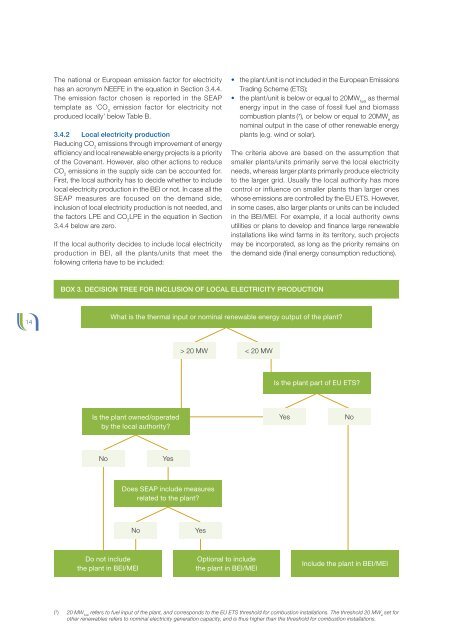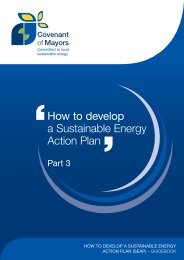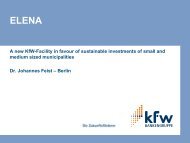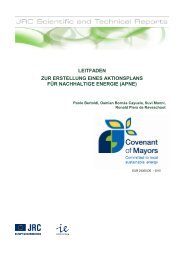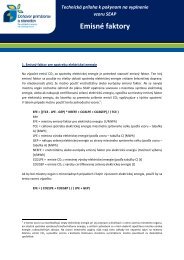English - Covenant of Mayors
English - Covenant of Mayors
English - Covenant of Mayors
Create successful ePaper yourself
Turn your PDF publications into a flip-book with our unique Google optimized e-Paper software.
The national or European emission factor for electricity<br />
has an acronym NEEFE in the equation in Section 3.4.4.<br />
The emission factor chosen is reported in the SEAP<br />
template as ‘CO 2<br />
emission factor for electricity not<br />
produced locally’ below Table B.<br />
3.4.2 Local electricity production<br />
Reducing CO 2<br />
emissions through improvement <strong>of</strong> energy<br />
efficiency and local renewable energy projects is a priority<br />
<strong>of</strong> the <strong>Covenant</strong>. However, also other actions to reduce<br />
CO 2<br />
emissions in the supply side can be accounted for.<br />
First, the local authority has to decide whether to include<br />
local electricity production in the BEI or not. In case all the<br />
SEAP measures are focused on the demand side,<br />
inclusion <strong>of</strong> local electricity production is not needed, and<br />
the factors LPE and CO 2<br />
LPE in the equation in Section<br />
3.4.4 below are zero.<br />
If the local authority decides to include local electricity<br />
production in BEI, all the plants/units that meet the<br />
following criteria have to be included:<br />
• the plant/unit is not included in the European Emissions<br />
Trading Scheme (ETS);<br />
• the plant/unit is below or equal to 20MW fuel<br />
as thermal<br />
energy input in the case <strong>of</strong> fossil fuel and biomass<br />
combustion plants ( 7 ), or below or equal to 20MW e<br />
as<br />
nominal output in the case <strong>of</strong> other renewable energy<br />
plants (e.g. wind or solar).<br />
The criteria above are based on the assumption that<br />
smaller plants/units primarily serve the local electricity<br />
needs, whereas larger plants primarily produce electricity<br />
to the larger grid. Usually the local authority has more<br />
control or influence on smaller plants than larger ones<br />
whose emissions are controlled by the EU ETS. However,<br />
in some cases, also larger plants or units can be included<br />
in the BEI/MEI. For example, if a local authority owns<br />
utilities or plans to develop and finance large renewable<br />
installations like wind farms in its territory, such projects<br />
may be incorporated, as long as the priority remains on<br />
the demand side (final energy consumption reductions).<br />
BOX 3. DECISION TREE FOR INCLUSION OF LOCAL ELECTRICITY PRODUCTION<br />
14<br />
What is the thermal input or nominal renewable energy output <strong>of</strong> the plant?<br />
> 20 MW<br />
< 20 MW<br />
Is the plant part <strong>of</strong> EU ETS?<br />
Is the plant owned/operated<br />
by the local authority?<br />
Yes<br />
No<br />
No<br />
Yes<br />
Does SEAP include measures<br />
related to the plant?<br />
No<br />
Yes<br />
Do not include<br />
the plant in BEI/MEI<br />
Optional to include<br />
the plant in BEI/MEI<br />
Include the plant in BEI/MEI<br />
(7) 20 MW fuel<br />
refers to fuel input <strong>of</strong> the plant, and corresponds to the EU ETS threshold for combustion installations. The threshold 20 MW e<br />
set for<br />
other renewables refers to nominal electricity generation capacity, and is thus higher than the threshold for combustion installations.


